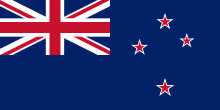New Zealand at the 1972 Summer Paralympics
| New Zealand at the 1972 Summer Paralympics | |
|---|---|
 | |
| IPC code | NZL |
| NPC | Paralympics New Zealand |
| Website | paralympics |
| in Heidelberg | |
| Competitors | 10 |
| Medals |
|
| Summer Paralympics appearances (overview) | |
New Zealand sent a delegation to compete at the 1972 Summer Paralympics in Heidelberg, West Germany. They sent ten competitors, seven male and three female.[1] The team consisted of Graham Condon, Leo Close, Neroli Fairhall, Graeme Marett, Keith McCormick, Dennis Miller, Tina Morgan, Chris Nicholls, Eve Rimmer, and Jim Savage.[2]
The New Zealand contingent brought back nine medals, with five of the ten competitors obtaining medals.[2]
Medallists
[edit]| Medal | Name | Sport | Event |
|---|---|---|---|
| Graham Condon | Athletics | Men's Discus 3 | |
| Eve Rimmer | Athletics | Women's Pentathlon 3 | |
| Eve Rimmer | Athletics | Women's Shot Put 3 | |
| Graeme Marett | Athletics | Men's Discus 2 | |
| Eve Rimmer | Athletics | Women's Discus 3 | |
| Eve Rimmer | Athletics | Women's Javelin 3 | |
| Graeme Marett | Athletics | Men's Pentathlon 2 | |
| Jim Savage | Athletics | Men's Shot Put 3 | |
| Tina Morgan | Swimming | Women's 25 m Freestyle 1B |
Disability classifications
[edit]Athletes at the Paralympics in 1972 were all afflicted by spinal cord injuries and required the use of a wheelchair.[4] This is in contrast to later Paralympics that include events for participants that fit into any of five different disability categories; amputation, either congenital or sustained through injury or illness; cerebral palsy; wheelchair athletes; visual impairment, including blindness; Les autres, any physical disability that does not fall strictly under one of the other categories, for example dwarfism or multiple sclerosis.[5][6] Each Paralympic sport then has its own classifications, dependent upon the specific physical demands of competition. Events are given a code, made of numbers and letters, describing the type of event and classification of the athletes competing.[7]
References
[edit]- ^ "Participants Heidelberg 1972 Paralympic Games". International Paralympic Committee. 1972. Retrieved 27 May 2011.
- ^ a b 1972 SUMMER PARALYMPIC GAMES: NEW ZEALAND TEAM
- ^ "IPC Historical Results Database - Athlete search by games - year (1972) medallists (all) and country (NZL)". paralympic.org. Retrieved 17 June 2016.
- ^ "Paralympic Games". International Paralympic Committee. Retrieved 29 May 2011.
- ^ "Paralympics categories explained". ABC. 3 September 2008. Retrieved 27 May 2011.
- ^ "Making sense of the categories". BBC Sport. 6 October 2000. Retrieved 27 May 2011.
- ^ "A-Z of Paralympic classification". BBC Sport. 28 August 2008. Retrieved 27 May 2011.
